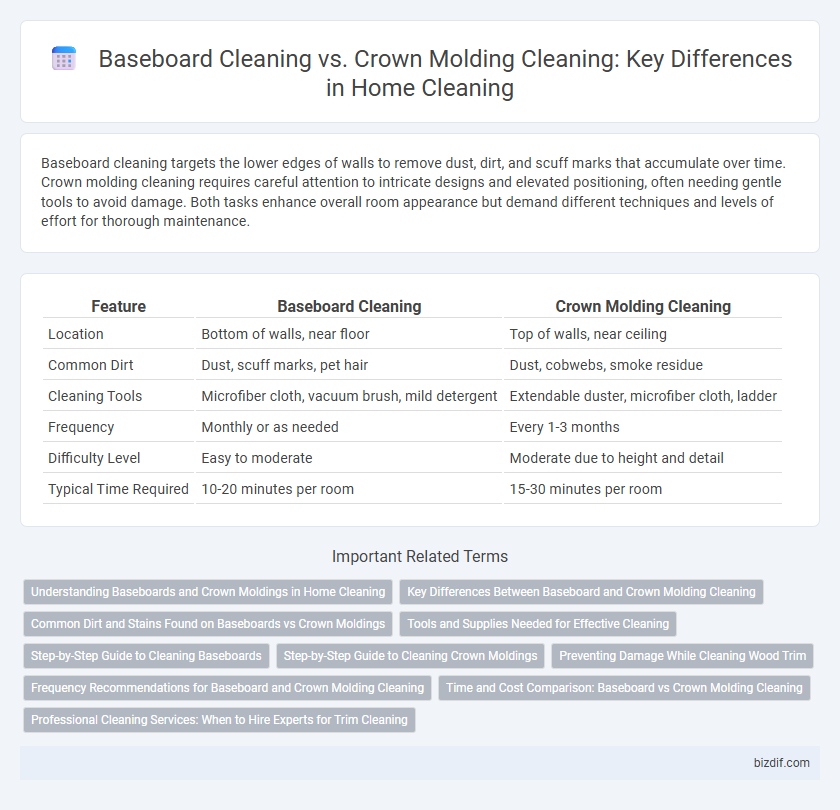Baseboard cleaning targets the lower edges of walls to remove dust, dirt, and scuff marks that accumulate over time. Crown molding cleaning requires careful attention to intricate designs and elevated positioning, often needing gentle tools to avoid damage. Both tasks enhance overall room appearance but demand different techniques and levels of effort for thorough maintenance.
Table of Comparison
| Feature | Baseboard Cleaning | Crown Molding Cleaning |
|---|---|---|
| Location | Bottom of walls, near floor | Top of walls, near ceiling |
| Common Dirt | Dust, scuff marks, pet hair | Dust, cobwebs, smoke residue |
| Cleaning Tools | Microfiber cloth, vacuum brush, mild detergent | Extendable duster, microfiber cloth, ladder |
| Frequency | Monthly or as needed | Every 1-3 months |
| Difficulty Level | Easy to moderate | Moderate due to height and detail |
| Typical Time Required | 10-20 minutes per room | 15-30 minutes per room |
Understanding Baseboards and Crown Moldings in Home Cleaning
Baseboard cleaning targets the lower perimeter of walls, focusing on removing dust, scuffs, and grime that accumulate near floors, which can harbor allergens and affect indoor air quality. Crown molding cleaning requires careful attention to elevated and often intricate architectural details, where dust and cobwebs gather but dirt buildup is typically lighter than on baseboards. Understanding these differences helps tailor cleaning methods and tools to preserve the material finish and enhance overall home cleanliness.
Key Differences Between Baseboard and Crown Molding Cleaning
Baseboard cleaning typically involves removing dust, dirt, and scuff marks from low wall trim near the floor, requiring attention to accumulated grime and potential damage from furniture contact. Crown molding cleaning targets the decorative, elevated trim near the ceiling, often necessitating gentle dusting and careful removal of cobwebs or dirt due to its intricate design and height. The key differences lie in their location, the type of dirt buildup, and cleaning techniques, with baseboards demanding more scrubbing and crown moldings requiring delicate handling.
Common Dirt and Stains Found on Baseboards vs Crown Moldings
Baseboards often accumulate scuff marks, dust, pet hair, and dirt along with shoe grime due to their proximity to floors, making them prone to sticky residues and grime buildup. Crown moldings typically gather dust, spider webs, and airborne grease or smoke stains because of their elevated position near ceilings and kitchens. Both surfaces require targeted cleaning methods to effectively remove the unique dirt and stains they attract.
Tools and Supplies Needed for Effective Cleaning
Effective baseboard cleaning typically requires tools such as microfiber cloths, soft-bristle brushes, and a mild detergent or all-purpose cleaner to remove dust and scuffs without damaging paint. Crown molding cleaning demands more precise tools like extendable dusters, angled brushes, and gentle cleaners to reach high corners and intricate designs without causing wear. Both tasks benefit from using vacuum attachments with brush heads to capture loose dirt and dust before wiping surfaces for a thorough clean.
Step-by-Step Guide to Cleaning Baseboards
Start by dusting baseboards with a microfiber cloth or vacuum attachment to remove loose dirt and dust. Next, prepare a cleaning solution of warm water and mild detergent, then scrub the baseboards gently using a soft sponge or brush to eliminate grime and scuff marks. Finish by wiping the baseboards with a clean, damp cloth and drying them thoroughly to prevent moisture damage, ensuring a fresh and polished appearance.
Step-by-Step Guide to Cleaning Crown Moldings
Cleaning crown moldings requires careful attention to detail and specific tools like a microfiber cloth, a soft-bristle brush, and a mild cleaning solution to avoid damage. Start by dusting the surface with a microfiber cloth, then use the brush to reach intricate corners, finally wiping down with a damp cloth to remove residue. Unlike baseboard cleaning--which primarily involves wiping lower surfaces--crown molding cleaning demands precision due to its elevated and decorative placement, ensuring no dust accumulates in crevices.
Preventing Damage While Cleaning Wood Trim
Preventing damage while cleaning wood trim requires understanding the differences between baseboard cleaning and crown molding cleaning techniques. Baseboards often accumulate dust and scuff marks, so using a soft microfiber cloth and gentle wood cleaner minimizes abrasion and preserves the finish. Crown molding, typically located higher and more intricate, demands careful dusting with a soft brush or vacuum attachment to avoid scratching or chipping delicate edges.
Frequency Recommendations for Baseboard and Crown Molding Cleaning
Baseboard cleaning should be performed every 3 to 6 months to prevent dust accumulation and maintain a fresh appearance, especially in high-traffic areas. Crown molding requires less frequent cleaning, typically every 6 to 12 months, since it collects less dust but still benefits from periodic dusting to preserve its detailed craftsmanship. Regular cleaning intervals ensure both baseboards and crown molding contribute to a well-maintained and polished home environment.
Time and Cost Comparison: Baseboard vs Crown Molding Cleaning
Baseboard cleaning typically requires less time and lower costs due to its straightforward design and ease of access, often completed within 15 to 30 minutes per room using basic cleaning tools. Crown molding cleaning demands more time and higher expenses because of its elevated and intricate placement, necessitating ladders and specialized dusting tools, which can extend cleaning time to 30-60 minutes per room. Budgeting for crown molding cleaning should account for these factors, as professional services often charge 20-50% more compared to baseboard cleaning.
Professional Cleaning Services: When to Hire Experts for Trim Cleaning
Professional cleaning services for baseboard cleaning are essential when dirt accumulates in hard-to-reach corners or involves stubborn stains that require specialized tools. Crown molding cleaning often demands expertise due to its intricate design and elevated placement, making professional intervention necessary to avoid damage and ensure thorough dust and grime removal. Hiring experts for trim cleaning guarantees the use of appropriate techniques and products, preserving the finish and enhancing the overall appearance of interior spaces.
Baseboard cleaning vs Crown molding cleaning Infographic

 bizdif.com
bizdif.com